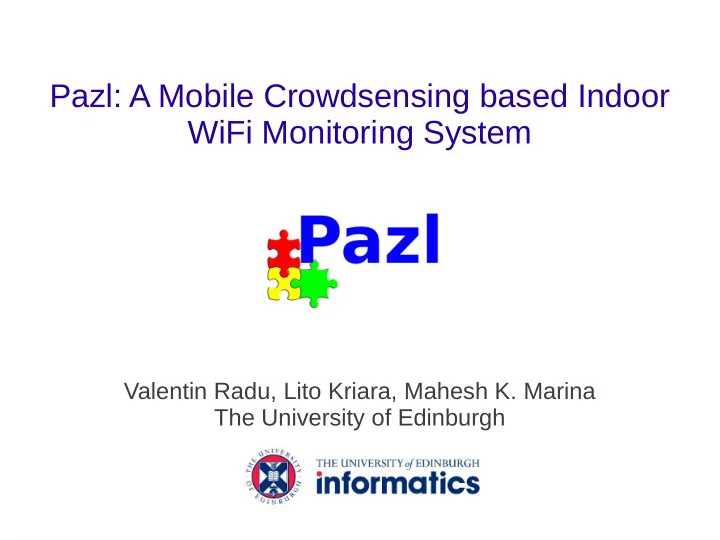

Pazl: A Mobile Crowdsensing based Indoor WiFi Monitoring System Valentin Radu, Lito Kriara, Mahesh K. Marina The University of Edinburgh
Introduction ● 6 billion mobile subscriptions in the world [source: UN report, 2013] . ● 1.4 billion smartphones will be in use by December 2013 [source: ABI, 2013] and expected to reach 2 billion by 2015 [source: Strategy Analytics, 2013] .
Motivation WLANs require permanent monitoring to capture all the dynamic aspects. In the Informatics Forum: Dynamic fluctuation of APs number at a single location 5
Motivation In the Informatics Forum: Channel imbalance Manual site survey with Ekahau observing some coverage holes 6
Motivation In the Informatics Forum: Channel imbalance Need for continuous Manual site survey with Ekahau monitoring in space and time. observing some coverage holes 7
Motivation ● Traditional site surveys are expensive, intrusive and time consuming. ● People carry smartphones that can perform ubiquitous sensing.
Motivation ● Traditional site surveys are expensive, intrusive and time consuming. ● People carry smartphones that can perform ubiquitous sensing.
Motivation ● Traditional site surveys are expensive, intrusive and time consuming. ● People carry smartphones that can perform ubiquitous sensing.
Pazl Pazl - a mobile crowdsensing based indoor WiFi monitoring system.
Pazl Pazl - a mobile crowdsensing based WiFi monitoring system. Continuous monitoring of the WiFi environment
Challenges ● To map any data we need to annotate it with its location. ● GPS is an established localization solution for outdoors, but not very reliable inside a building. ● Indoor localization: – WiFi fingerprinting or – Pedestrian Dead Reckoning (PDR).
Background – WiFi fingerprinting Offline phase – data collection sample WiFi environment WiFi fingerprint AP1 RSSI1 AP2 RSSI2 Location APn RSSIn Online phase – localization
Disadvantages of WiFi Fingerprinting 1. needs WiFi coverage. 2. Scanning the WiFi environment requires substantial amount of energy. ● one order of magnitude more than the energy requirements for the accelerometer and compass. ● not suitable for continuous tracking. 3. Many interferences (microwave ovens, people). 4. Disruptions in communication when done excessively.
Background - PDR How it works? ● Compute consecutive positions starting from a known position ● Distance estimation ● Direction estimation distance ● Counting the number of steps. ● Step detection from acceleration: - Zero-crossing – count the number of acceleration known crossing 0 value. position - Peak detection - Auto-correlation – repetitiveness of human walking. ● Step length as a linear function of stepping frequency (R. Harle, 2012)
Background - PDR How it works? ● Compute consecutive positions starting from a known position ● Distance estimation ● Direction estimation distance Smartphones nowadays known come equipped with position direction magnetometers and gyros.
Background - PDR How it works? ● Compute consecutive positions starting from a known position ● Distance estimation ● Direction estimation known Disadvantages: position - noisy sensors - error accumulation
Pazl's localization solution Application specific – PDR with periodic WiFi fingerprint and map knowledge assistance.
Activity recognition ● Activity recognition based on acceleration magnitude: a = √ a x 2 + a y 2 + a z 2 − g ● Feature extraction: in time domain (mean, standard deviation, variant, correlation between axes) and in frequency domain (energy and entropy). ● Activity classifier trained for: – Walking – Static – Going up on stairs Window size J48 Naive-Bayes FT(tree) – Going down on stairs 128 samples 70.5% 81.7% 80.5% – Elevator moving up – Elevator moving down 256 samples 74.2% 85.3% 81.9% – Opening and closing doors (both in hand and in pocket) ● On the server Weka toolkit was used to classify the acceleration samples to activities.
WiFi fingerprinting ● Euclidean distance approach. ● Vector of top 5 APs in signal strength ● Centroid of closest three matches ● Cells 1x1m We have observed that some locations have consistently better accuracy.
WiFi fingerprinting ● Inaccuracy perimeter – the perimeter defined by the first three closest matching fingerprints in the database.
WiFi fingerprinting ● Inaccuracy perimeter – the perimeter defined by the first three closest matching fingerprints in the database.
Particle filter ● In the PDR, we observed that compass deviations and distance deviations between estimations and ground truth follow a close to normal distribution. W 0 2 −( x − μ ) 1 2 2σ f ( x )= σ √ 2π e W c – Weight on the orientation choice W d – Weight on the distance choice W a – Weight from activity confidence. Activity selection W f – Weight on distance to WiFi fix W = W 0 + W d + W c + W a + W f
Particle filter
Related work ● Building radio maps for WiFi fingerprinting using PDR. – WiFi-SLAM (B. Ferris et al., 2007) – ZEE (A. Rai et al., 2012).
Evaluation – Pazl localization system ● 5 participants on a track of 100 meters.
System Design ● Mobile application collecting sensor data on the phone ● Opportunistic data upload to the server for computations ● Server application running in the cloud ● Data is annotated with a location ● Create WiFi status reports
Evaluation – Pazl ● WiFi database was built by two participants. ● Activity classifier trained with the samples from two participants. ● In the experiment, 5 participants moved freely in the building for the period of a working day (10am-6pm). ● Monitoring at first floor in Informatics Forum.
Pazl site survey
Pazl compared to Ekahau
Future Work ● Remaining challenges – Energy-efficiency for long term running systems – Bootstrapping the application with indoor-outdoor transition detection ● Automate network management decisions using Pazl reports. ● Monitor other wireless environments.
Conclusions ● We move the monitoring perspective from the infrastructure to the client. ● Continuous monitoring through users mobility. ● Crowds map phenomena of common interest. ● Application specific indoor localization using a hybrid approach.
Thank you! Questions?
Valentin.Radu@ed.ac.uk WiMo Group The University of Edinburgh
Recommend
More recommend